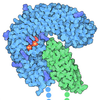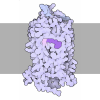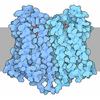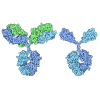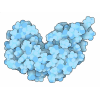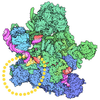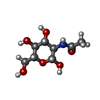+ Open data
Open data
- Basic information
Basic information
| Entry | Database: PDB / ID: 9kb6 | ||||||
|---|---|---|---|---|---|---|---|
| Title | Cryo-EM structure of LGR4 | ||||||
 Components Components | Leucine-rich repeat-containing G-protein coupled receptor 4 | ||||||
 Keywords Keywords | MEMBRANE PROTEIN / Wnt signal | ||||||
| Function / homology |  Function and homology information Function and homology informationmetanephric glomerulus development / metanephric nephron tubule morphogenesis / epithelial cell proliferation involved in renal tubule morphogenesis / protein-hormone receptor activity / intestinal stem cell homeostasis / negative regulation of toll-like receptor signaling pathway / positive regulation of branching involved in ureteric bud morphogenesis / male genitalia development / bone remodeling / digestive tract development ...metanephric glomerulus development / metanephric nephron tubule morphogenesis / epithelial cell proliferation involved in renal tubule morphogenesis / protein-hormone receptor activity / intestinal stem cell homeostasis / negative regulation of toll-like receptor signaling pathway / positive regulation of branching involved in ureteric bud morphogenesis / male genitalia development / bone remodeling / digestive tract development / negative regulation of cold-induced thermogenesis / negative regulation of cytokine production / bone mineralization / hair follicle development / Regulation of FZD by ubiquitination / circadian regulation of gene expression / G protein-coupled receptor activity / Wnt signaling pathway / osteoblast differentiation / transmembrane signaling receptor activity / positive regulation of canonical Wnt signaling pathway / spermatogenesis / innate immune response / plasma membrane Similarity search - Function | ||||||
| Biological species |  Homo sapiens (human) Homo sapiens (human) | ||||||
| Method | ELECTRON MICROSCOPY / single particle reconstruction / cryo EM / Resolution: 3.53 Å | ||||||
 Authors Authors | Peng, Y. / Fujimura, A. / Asami, J. / Zhang, Z. / Shimizu, T. / Ohto, U. | ||||||
| Funding support |  Japan, 1items Japan, 1items
| ||||||
 Citation Citation |  Journal: Nat Commun / Year: 2025 Journal: Nat Commun / Year: 2025Title: Structural insights into Wnt/β-catenin signaling regulation by LGR4, R-spondin, and ZNRF3. Authors: Yuxuan Peng / Akiko Fujimura / Jinta Asami / Zhikuan Zhang / Toshiyuki Shimizu / Umeharu Ohto /  Abstract: Leucine-rich repeat-containing G protein-coupled receptor 4 (LGR4) plays a critical role in regulating the wingless-related integration site (Wnt) signaling pathway and is essential for organ ...Leucine-rich repeat-containing G protein-coupled receptor 4 (LGR4) plays a critical role in regulating the wingless-related integration site (Wnt) signaling pathway and is essential for organ development and carcinogenesis. LGR4, along with its ligand R-spondin (RSPO), potentiates Wnt/β-catenin signaling by recruiting its signaling suppressor, E3 ligase Zinc and Ring Finger 3 (ZNRF3), and inducing its membrane clearance. However, detailed mechanisms underlying this process remain unknown. In this study, we present the cryo-electron microscopy structures of human LGR4, the LGR4-RSPO2 and LGR4-RSPO2-ZNRF3 complexes. Upon RSPO2 binding, LGR4 undergoes no significant conformational changes in its transmembrane and extracellular domain structures or their relative orientations. LGR4, RSPO2, and ZNRF3 assemble into a 2:2:2 complex with the ZNRF3 dimer enclosed at the center. This ternary arrangement and forced dimerization of ZNRF3 likely underpin how LGR4 and RSPO2 potentiate Wnt/β-catenin signaling by sequestering ZNRF3 from Wnt receptors and facilitating its auto-inactivation. This study provides a structural basis for understanding the regulatory mechanism of Wnt/β-catenin signaling through the LGR4-RSPO2-ZNRF3 pathway and may offer opportunities for future drug development targeting this axis. | ||||||
| History |
|
- Structure visualization
Structure visualization
| Structure viewer | Molecule:  Molmil Molmil Jmol/JSmol Jmol/JSmol |
|---|
- Downloads & links
Downloads & links
- Download
Download
| PDBx/mmCIF format |  9kb6.cif.gz 9kb6.cif.gz | 171.4 KB | Display |  PDBx/mmCIF format PDBx/mmCIF format |
|---|---|---|---|---|
| PDB format |  pdb9kb6.ent.gz pdb9kb6.ent.gz | 126.4 KB | Display |  PDB format PDB format |
| PDBx/mmJSON format |  9kb6.json.gz 9kb6.json.gz | Tree view |  PDBx/mmJSON format PDBx/mmJSON format | |
| Others |  Other downloads Other downloads |
-Validation report
| Summary document |  9kb6_validation.pdf.gz 9kb6_validation.pdf.gz | 1.2 MB | Display |  wwPDB validaton report wwPDB validaton report |
|---|---|---|---|---|
| Full document |  9kb6_full_validation.pdf.gz 9kb6_full_validation.pdf.gz | 1.2 MB | Display | |
| Data in XML |  9kb6_validation.xml.gz 9kb6_validation.xml.gz | 36.3 KB | Display | |
| Data in CIF |  9kb6_validation.cif.gz 9kb6_validation.cif.gz | 51.4 KB | Display | |
| Arichive directory |  https://data.pdbj.org/pub/pdb/validation_reports/kb/9kb6 https://data.pdbj.org/pub/pdb/validation_reports/kb/9kb6 ftp://data.pdbj.org/pub/pdb/validation_reports/kb/9kb6 ftp://data.pdbj.org/pub/pdb/validation_reports/kb/9kb6 | HTTPS FTP |
-Related structure data
| Related structure data |  62218MC  9kb7C  9kb8C  9kb9C M: map data used to model this data C: citing same article ( |
|---|---|
| Similar structure data | Similarity search - Function & homology  F&H Search F&H Search |
- Links
Links
- Assembly
Assembly
| Deposited unit | 
|
|---|---|
| 1 |
|
- Components
Components
| #1: Protein | Mass: 93372.047 Da / Num. of mol.: 1 Source method: isolated from a genetically manipulated source Source: (gene. exp.)  Homo sapiens (human) / Gene: LGR4, GPR48 / Production host: Homo sapiens (human) / Gene: LGR4, GPR48 / Production host:  | ||||
|---|---|---|---|---|---|
| #2: Sugar | ChemComp-NAG / Has ligand of interest | N | Has protein modification | Y | |
-Experimental details
-Experiment
| Experiment | Method: ELECTRON MICROSCOPY |
|---|---|
| EM experiment | Aggregation state: PARTICLE / 3D reconstruction method: single particle reconstruction |
- Sample preparation
Sample preparation
| Component | Name: LGR4 / Type: COMPLEX / Entity ID: #1 / Source: RECOMBINANT |
|---|---|
| Source (natural) | Organism:  Homo sapiens (human) Homo sapiens (human) |
| Source (recombinant) | Organism:  |
| Buffer solution | pH: 7.5 |
| Specimen | Embedding applied: NO / Shadowing applied: NO / Staining applied: NO / Vitrification applied: YES |
| Vitrification | Cryogen name: ETHANE |
- Electron microscopy imaging
Electron microscopy imaging
| Experimental equipment |  Model: Titan Krios / Image courtesy: FEI Company |
|---|---|
| Microscopy | Model: TFS KRIOS |
| Electron gun | Electron source:  FIELD EMISSION GUN / Accelerating voltage: 300 kV / Illumination mode: FLOOD BEAM FIELD EMISSION GUN / Accelerating voltage: 300 kV / Illumination mode: FLOOD BEAM |
| Electron lens | Mode: BRIGHT FIELD / Nominal defocus max: 2000 nm / Nominal defocus min: 800 nm |
| Image recording | Electron dose: 60 e/Å2 / Film or detector model: GATAN K3 (6k x 4k) |
- Processing
Processing
| EM software | Name: PHENIX / Version: 1.20.1_4487: / Category: model refinement | ||||||||||||||||||||||||
|---|---|---|---|---|---|---|---|---|---|---|---|---|---|---|---|---|---|---|---|---|---|---|---|---|---|
| CTF correction | Type: PHASE FLIPPING AND AMPLITUDE CORRECTION | ||||||||||||||||||||||||
| 3D reconstruction | Resolution: 3.53 Å / Resolution method: FSC 0.143 CUT-OFF / Num. of particles: 421944 / Symmetry type: POINT | ||||||||||||||||||||||||
| Refine LS restraints |
|
 Movie
Movie Controller
Controller






 PDBj
PDBj
